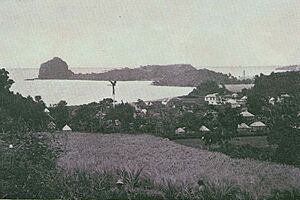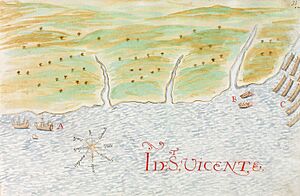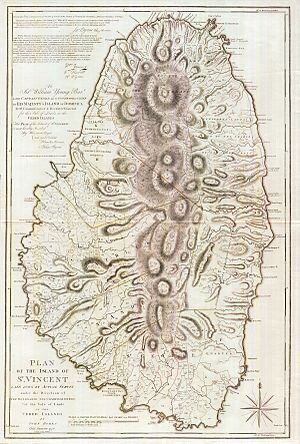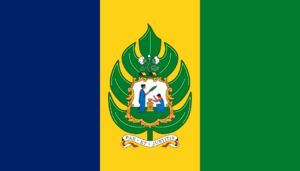History of Saint Vincent and the Grenadines facts for kids

The islands of St. Vincent and the Grenadines were first home to different Amerindian groups. Europeans arrived in the early 1500s but did not settle right away. The French finally settled the island in Barrouallie in 1717. However, the English had claimed St. Vincent back in 1627.
After a war, St. Vincent was given to Britain in 1763 by the Treaty of Paris. This led to conflicts with the British, known as the First and Second Carib War, in the late 1700s. But the British kept control of the islands.
In 1877, a special British government called a Crown Colony was set up. A council was created in 1925, and all adults were allowed to vote in 1951. St. Vincent and the Grenadines became fully independent on October 27, 1979. It was the last of the Windward Islands to gain independence.
Contents
Early History of the Islands
Before Europeans and Africans came in the 1500s, different groups of Amerindian people lived on or passed through St. Vincent and the Grenadines. These included the Ciboney, Arawak, and Carib people. They likely came from the Orinoco Valley in South America. From there, they traveled north through Trinidad and the Lesser Antilles islands.
By the time Christopher Columbus sailed near St. Vincent in 1498, the Caribs were living on the island. They had taken over from the Arawaks a few centuries earlier.
First European Visitors
Columbus and the Spanish explorers mostly ignored St. Vincent and the smaller Grenadine islands. They were more interested in finding gold and silver in Central and South America. However, the Spanish did send ships to capture people for slavery around St. Vincent after 1511. This forced the Carib people to move to the rough, hilly parts of the island. But the Spanish never tried to settle there.
The Carib people strongly prevented Europeans from settling on St. Vincent until the 1700s. Some African slaves either survived shipwrecks or escaped from nearby islands like St. Lucia or Grenada. They found safety in St. Vincent and married into the Carib communities. These people became known as "black Caribs." Today, people with both African and Carib ancestors are called Garifuna.
French and British Take Control
The French were the first Europeans to settle on St. Vincent. Even though England claimed the island in 1627, the French, who were based in Martinique, started their first colony in Barrouallie in 1719. French settlers grew crops like coffee, tobacco, and sugar on large farms. African slaves were forced to work on these farms.
St. Vincent was given to Britain in 1763 as part of the Treaty of Paris (1763). From that time until its independence, St. Vincent was a British colony.
The Carib Wars
Conflicts between the British and the Caribs led to the First Carib War. This war (1769–1773) happened because the British tried to expand their settlements into land where the Black Caribs lived. The war ended in a tie, with a peace agreement that didn't fully satisfy anyone.
The Caribs, led by their chief Joseph Chatoyer, successfully defended their land against British soldiers in 1769. They refused to sell their land to the British government. Because the British saw this as stubbornness, they launched a full military attack on the Caribs in 1772. Their goal was to defeat the Caribs and force them off the island.
However, the British soldiers were not used to the island's difficult mountain areas. The Caribs defended their land well, stopping the British advance. People in London also started to question the war. With no clear winner, a peace agreement was signed in 1773. This agreement set clear borders between the British and Carib areas of the island.
In 1776, the British allowed a local assembly to be formed. France captured Saint Vincent in 1779 during the American War of Independence. But the island was given back to Britain in 1783 by the Treaty of Versailles (1783).
The Second Carib War began in March 1795. The Caribs had many old complaints against the British government. They were also supported by French advisors, including a radical leader named Victor Hugues. The Caribs took control of most of the island, except for the area right around Kingstown. British soldiers arriving just in time saved Kingstown from being attacked several times.
The British struggled to control the island's interior and windy eastern side. This was due to their own mistakes, diseases, and strong Carib defenses. Some French troops from Martinique also arrived to help the Caribs. Finally, a large British military force led by General Ralph Abercromby defeated the Carib opposition in 1797.
More than 5,000 Black Caribs were forced to leave Saint Vincent. First, they were sent to the island of Baliceaux, near Bequia, where many died. Then, they were moved to the island of Roatán off the coast of Honduras. There, they became known as the Garifuna people.
After Slavery
Like the French, the British also used African slaves to work on farms growing sugar, coffee, and cotton. Slavery was ended by the British in 1834, and full freedom was achieved in 1838. After this, the economy faced problems. Many landowners left their farms, and the land was then farmed by the newly freed slaves.
Because there weren't enough workers on the farms, people from Portugal came in the 1840s. Later, people from East India came in the 1860s to work. Life remained hard for both former slaves and immigrant workers. Low sugar prices around the world kept the economy slow until the early 1900s.
A Crown Colony government was set up in 1877. A Legislative Council was created in 1925, and all adults were allowed to vote in 1951. During this time, the British tried several times to join St. Vincent with other Windward Islands. They wanted to govern the region as one unit. The most famous attempt was the West Indies Federation, which broke apart in 1962.
The La Soufriere volcano erupted in 1812 and 1902. These eruptions destroyed much of the island and killed many people. In 1979, it erupted again, but this time no one died. In the same year, St. Vincent and the Grenadines became fully independent from Britain. It remains a member of the Commonwealth of Nations.
Self-Rule and Independence
St. Vincent gained "associate statehood" on October 27, 1969. This meant it had full control over its own affairs. After a public vote in 1979, St. Vincent and the Grenadines became the last of the Windward Islands to gain full independence on October 27, 1979.
In November 2020, Ralph Gonsalves, who has been the Prime Minister of Saint Vincent and the Grenadines since 2001, made history. His Unity Labour Party (ULP) won its fifth election in a row.
Natural Disasters
Natural disasters have caused problems for the country throughout the 1900s and 2000s. In 1902, the Soufrière volcano erupted, killing 2,000 people. Much farmland was damaged, and the economy suffered. In April 1979, La Soufrière erupted again. No one was killed, but thousands had to leave their homes, and farms were badly damaged.
The island also gets hit by hurricanes. On September 11, 1898, a terrible hurricane hit Barrouallie for six hours. The town was almost completely destroyed. More recently, hurricanes in 1980 and 1987 damaged banana and coconut farms. The years 1998 and 1999 also had many strong hurricanes. Hurricane Lenny in 1999 caused a lot of damage to the island's west coast.
In 2021, on April 9, the La Soufrière volcano erupted again. It sent ash several miles into the air. About 16,000 people were moved to safety in the days before the eruption.
Images for kids
-
Engraving 'after Agostino Brunias' (ca 1801) entitled A Negro Festival drawn from Nature in the Island of St Vincent. National Maritime Museum, Greenwich
See also
 In Spanish: Historia de San Vicente y las Granadinas para niños
In Spanish: Historia de San Vicente y las Granadinas para niños
- British colonization of the Americas
- French colonization of the Americas
- History of the Americas
- History of the British West Indies
- History of North America
- History of the Caribbean
- List of prime ministers of Saint Vincent and the Grenadines
- Politics of Saint Vincent and the Grenadines
- Saint Vincent and the Grenadines
- Spanish colonization of the Americas










